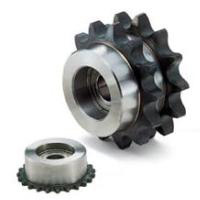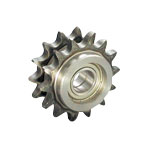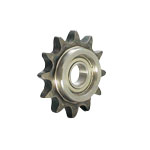(!)NOTE : Windows 7 users won’t be able to use some latest features of eCatalog/WOS since Microsoft is ending support for Windows 7 on 14 Jan, 2020. Please upgrade your system for uninterrupted services.
- Notice of End of Sales for Economy Series Pneumatic Equipment Category. More information.
Idlers(Surface Treatment:Tooth Surface Hardening)
An idler is a gear-shaped part that rotates as a chain moves. It is used in various machines, such as automobile engines, compressors, and power generators that transmit power using belts and chains. However, idlers themselves are idle gears that do not transmit power to gears or shafts. By using an idler, it is pos
An idler is a gear-shaped part that rotates as a chain moves. It is used in various machines, such as automobile engines, compressors, and power generators that transmit power using belts and chains. However, idlers themselves are idle gears that do not transmit power to gears or shafts. By using an idler, it is possible to maintain suitable transmission tension and stable movement. In addition, there are gear-shaped sprockets that transmit rotation, idler pins for fixing the idler with nuts and screws, tensioners for adjusting the slackness and friction of the chain, etc., and guide rollers for sliding doors. In particular, there are three types of sprockets: A type on a flat plate without a boss, B type with a boss on one side, and C type with a boss on both sides.
|
Sprocket Shape
|
|
|---|---|
Brand |
|
| CAD |
|
| Days to Ship |
|
3 items
- Sort By
-
You can add up to 6 items per a category to the compare list.

NABEYA BI-TECH
S25C to S35C, Induction hardened Tooth Tip
Sprocket Shape Nominal Number No. of Teeth(T) Shaft Bore Dia. D(mm) Material Type No. of Tracks Chain Type Shaft Type Surface Treatment Shape B 25 ~ 80 13 ~ 23 10 ~ 20 Steel Idlers 1 / 2 RS Bearing Built-in, Double Tooth Surface Hardening From: ₹ 2,998.78 Days to Ship: 5 Day(s) or more  5 Day(s) or more
5 Day(s) or more
-
You can add up to 6 items per a category to the compare list.

KONISHI
New at MISUMI? Get 20% Discount on your First Purchase. Click to Register Now
[Features]·2-row chain sprocket idler. [Materials]·Steel S35C (sprocket). ·Bearing steel (bearing)- CAD :
- 2D
Sprocket Shape Nominal Number No. of Teeth(T) Shaft Bore Dia. D(mm) Material Type No. of Tracks Chain Type Shaft Type Surface Treatment Shape B 40 ~ 60 12 ~ 17 20 - Idlers 2 RS Bearing Built-in, Double Tooth Surface Hardening From: ₹ 4,082.69 Days to Ship: 5 Day(s) or more  5 Day(s) or more
5 Day(s) or more
-
You can add up to 6 items per a category to the compare list.

KONISHI
[Materials]Sprocket: Steel material S35C, tooth tip induction hardened. Bearing: Bearing steel
- CAD :
- 2D
Sprocket Shape Nominal Number No. of Teeth(T) Shaft Bore Dia. D(mm) Material Type No. of Tracks Chain Type Shaft Type Surface Treatment Shape B 35 ~ 50 14 ~ 21 20 - Idlers 1 RS Bearing Built-in, Single Tooth Surface Hardening From: ₹ 2,130.35 Days to Ship: 5 Day(s) or more  5 Day(s) or more
5 Day(s) or more
| Brand |
|---|
| Product Series |
| CAD |
| From |
| Days to Ship |
| Sprocket Shape |
| Nominal Number |
| No. of Teeth(T) |
| Shaft Bore Dia. D(mm) |
| Material |
| Type |
| No. of Tracks |
| Chain Type |
| Shaft Type |
| Surface Treatment |
You can add up to 6 items per a category to the compare list. | You can add up to 6 items per a category to the compare list. | You can add up to 6 items per a category to the compare list. | |
| Brand | NABEYA BI-TECH | KONISHI | KONISHI |
| Product Series | |||
| CAD |
|
|
|
| From | ₹ 2,998.78 | ₹ 4,082.69 | ₹ 2,130.35 |
| Days to Ship | 5 Day(s) or more | 5 Day(s) or more | 5 Day(s) or more |
| Sprocket Shape | Shape B | Shape B | Shape B |
| Nominal Number | 25 ~ 80 | 40 ~ 60 | 35 ~ 50 |
| No. of Teeth(T) | 13 ~ 23 | 12 ~ 17 | 14 ~ 21 |
| Shaft Bore Dia. D(mm) | 10 ~ 20 | 20 | 20 |
| Material | Steel | - | - |
| Type | Idlers | Idlers | Idlers |
| No. of Tracks | 1 / 2 | 2 | 1 |
| Chain Type | RS | RS | RS |
| Shaft Type | Bearing Built-in, Double | Bearing Built-in, Double | Bearing Built-in, Single |
| Surface Treatment | Tooth Surface Hardening | Tooth Surface Hardening | Tooth Surface Hardening |
Loading...
Configure
Specification/Dimensions
-
Nominal Number
-
No. of Teeth(T)
-
Shaft Bore Dia. D(mm)
-
Material
- Steel
- Stainless Steel
- Engineering Plastic
-
Type
- Idlers
- Idler Pins
-
No. of Tracks
- 1
- 2
-
Chain Type
-
Shaft Type
-
Surface Treatment
Related Categories to Idlers
FAQ Idlers
- Question: What is an idler, and how does it work?
- Answer: An idler is a component used in various mechanical systems to maintain tension, guide, or support a belt, chain, or rope. It doesn't transmit power but helps in reducing friction and ensuring smooth motion by rotating freely. Idlers are commonly found in automotive systems, conveyor belts, and industrial machines.
- Question: What are the different types of idlers?
- Answer: There are several types of idlers, including:
• Roller idlers: These have cylindrical rollers that reduce friction and wear.
• Ball idlers: Similar to roller idlers but use ball bearings for even lower friction.
• Flanged idlers: These have flanges on either side to guide a belt or chain.
• Return idlers: Used in conveyor systems to return the belt or chain back to its starting point.
• Conveyor Idlers: Support the belt in conveyor systems.
• Tensioner Idlers: Help in maintaining proper tension in belts, particularly in automotive engines.
• Guide Idlers: Ensure that the belt or chain stays aligned.
• Flat Carry Idlers: Used in flat belt conveyor systems to support materials. - Question: Where are idlers commonly used?
- Answer: Idlers are found in various industries, including:
• Conveyor systems: To support and guide belts or chains.
• Power transmission systems: To change the direction of rotation or reduce friction in gears.
• Material handling equipment: To move and transport materials efficiently. - Question: What is the difference between a carrying idler and a return idler?
- Answer: A carrying idler supports the loaded side of a conveyor belt, while a return idler supports the empty side.
- Question: What is the purpose of a self-aligning idler?
- Answer: A self-aligning idler can compensate for slight misalignments in the conveyor belt or chain, reducing wear and tear.
- Question: What is the difference between an idler pulley and a tensioner pulley?
- Answer: An idler pulley helps guide the belt and maintains alignment, while a tensioner pulley actively applies pressure to keep the belt tight. Tensioner pulleys are spring-loaded or adjustable, whereas idler pulleys typically rotate freely without adjusting tension.
- Question: What factors should I consider when choosing an idler?
- Answer: When selecting an idler, consider the following:
• Material: Steel, aluminum, or plastic, depending on the load and environment.
• Size: Ensure the idler matches your system's belt or chain specifications.
• Load capacity: For conveyor systems, choose an idler capable of handling the weight of your materials.
• Speed rating: Ensure the idler can withstand the speed of your belt or chain.












How can we improve?
How can we improve?
Thank you for your time.
Your feedback is essential for our continuous improvement
Privacy Policy
Thank you for your cooperation.
Thank you for your time.
Your feedback is essential for our continuous improvement
Please use the inquiry form.
Privacy Policy